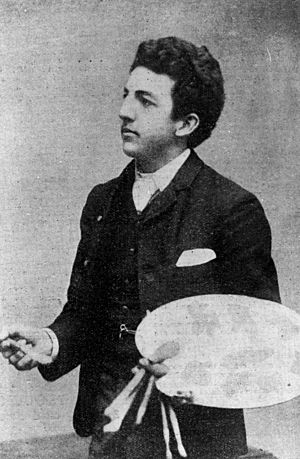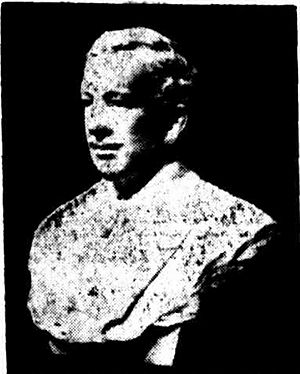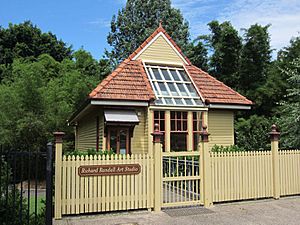Richard John Randall facts for kids
Richard John Randall (1869—1906) was an Australian artist. He lived and worked in Brisbane, Queensland. His special art studio, called the Richard Randall Art Studio, is now a protected historical site.
Contents
Richard Randall's Early Life
Richard John Randall was born in Brisbane in 1869. He was the first son of George and Naomi Randall. His parents had moved to Brisbane from England. Richard grew up in South Brisbane. His family owned a successful shop there.
Richard and his younger brother, George, both went to the Brisbane Normal School. Richard later took art classes at the Brisbane Technical College. This college started in 1882. While studying, he won awards for drawing and making models. Richard's watercolours and drawings were shown at the Queensland National Association exhibitions in the late 1880s.
Art in Queensland was quite new back then. The first art society began in 1887. Its main goal was to help art grow. It also wanted to start yearly art shows in Brisbane. At that time, artists had few places to show and sell their work. This society also hoped to create an art gallery for Queensland. Sydney and Melbourne already had art galleries. The first art show by the society was held in the Masonic Hall in Alice Street, Brisbane, on August 14, 1888.
In 1881, Richard's father, George Randall, became an agent for Queensland in Britain. This job meant he traveled to England often. He would visit different areas to encourage people to move to Queensland. He especially looked for farmers. Between 1881 and 1902, George Randall went to England four times for this job. One trip lasted five years. Meanwhile, the family's business in South Brisbane did very well. This allowed them to buy a lot of land. They also started a large farm called Somersby Grange in Birkdale.
Richard Randall's Time in Europe
In April 1891, Richard was 22 years old. He went to England with his mother and brother. They joined his father, George Randall, on his third trip. While in England, Richard continued his art studies. He applied to a famous art school. It was run by Professor Hubert von Herkomer in Bushey, Hertfordshire.
In December 1892, Richard was accepted into the Herkomer School. He spent several years there. He even earned a free scholarship and became a life member. In 1895, Richard Randall achieved his biggest success. One of his watercolour paintings, called "The Old Mill," was chosen. It was shown at the important Royal Academy of Arts exhibition.
After leaving the Herkomer School, Richard Randall worked in London for 18 months. He had a studio in Queensborough Terrace, Bayswater. During this time, he painted portraits of many important people. He also took trips to beautiful places around England and to Paris.
Richard Randall's Career in Queensland
In 1899, Richard Randall came back to Queensland. Some people say he returned because his father wanted him to. His father hoped Richard would use his training and talent. He wanted Richard to help improve art in his home city and country. Richard kept working as an artist in Brisbane. He joined art shows and competitions. In November 1899, he showed 50 of his watercolours for sale. People called him a "daring colourist" because of his bold use of colours. Soon, other artists in local shows started to be influenced by Randall's style.
Richard Randall decided to build his own home and studio in Brisbane. He chose a piece of land his father owned. It was at 72 Cordelia Street in South Brisbane. This spot was across from St Andrew's Church. A house called 'Hatfield' was built there around 1896. Early photos show this house and the later studio close together. Some say his father built the studio for Richard. But George Randall was in England when it was built in 1900. So, it's not clear how much he was involved, apart from providing the land. A story from 1914 says Richard himself oversaw the building of the studio.
The studio was built just for an artist. Its design was likely based on art studios in London. Richard Randall knew these studios well. They often had a large painting room. This room was used for working and for guests. They also had big windows and skylights for natural light. Blinds helped control the light. A window connected to a sloped skylight was very popular. It gave light from both the top and the side. The entrance was often close to the painting room. This meant models and visitors didn't have to walk through other parts of the house. These special studios showed that artists were becoming more respected in London.
Richard Randall's studio was not huge. It used local materials and building methods. But its design still showed many features of a London artist's studio. A Brisbane newspaper said it looked like a "Swiss chalet." It had an uneven front, a steep roof with special tiles, and a bay window. The studio was on the upper floor at street level. The house below was reached by stairs at the back. The studio itself was one big room. It had a large bay window and a skylight. Blinds helped control the light. A low wooden wall created an entrance area. A curtain hid the studio from the front door. The high walls were painted a "cool green." They had few windows, which meant lots of space to hang pictures. The room even had a "model's throne." A description from that time called it "a fine spacious studio (said to be one of the best-equipped private studios in Australia)."
Once he was settled, Richard Randall started advertising for students. He offered drawing and painting lessons. He taught using oils, watercolours, and pastels. On Wednesday afternoons, he was "at home" to visitors. This was a chance for people to socialize. It was also a chance for him to show his newest artworks. Richard worked, showed his art, and taught at the studio. He became a well-known and successful artist and teacher in Brisbane. He also became a central figure for other local artists who liked his style.
When he wasn't teaching, Richard traveled around south-east Queensland. He looked for new places and scenes to paint. He was also active in many art clubs. These included the Brisbane Sketching Club and the Queensland Art Society. He was the vice-president of the Queensland Art Society from December 1903. A new art group, called the New Society of Artists, formed in 1904. This happened because some artists were unhappy with the Queensland Art Society. In August 1906, a local newspaper announced Richard Randall's engagement. He was going to marry Miss Minna Wirth. Her father, Lewis Wirth, was an artist and one of the founders of the Queensland Art Society.
After returning to Australia, Richard was contacted by art galleries in London. They wanted to show his work. So, collections of his paintings were sent back to England. They were displayed for sale. His watercolours and paintings of Australian landscapes were especially liked. They showed a "more pleasing and favourable impression of the Australian bush and scenery than had hitherto been entertained."
Richard Randall's Death
Sadly, Richard Randall died unexpectedly in October 1906. He was only 37 years old. It is thought he died from a brain tumour. He passed away at Somersby Grange. His funeral on October 16 was well attended. Many people from Brisbane's art community were there. Members of the Queensland Art Society and the New Society of Artists attended. In a rare moment of unity, they acted as pallbearers.
Richard Randall's Legacy
Richard's death was a huge shock to his father. After 1906, his father spent much of his time promoting Richard's life and art. In 1907, he put together a special memorial book. It had photos of Richard, his studio, and some of his paintings. The studio and everything inside it were kept just as they were until about 1913. It was opened for the public and important guests to see. For example, the Governor and Lady Chelmsford visited in December 1906. They bought several watercolour sketches.
In 1909, the South Brisbane City Council agreed to take 600 of Richard's artworks. They would keep them forever. George Randall offered a quarter-acre of empty land next to the studio. He wanted a gallery built there to hold the collection. However, the collection ended up on the top floor of the South Brisbane Library. This library space was changed into the Randall Art Gallery. The Randall Collection had all kinds of his work. It included early sketches, unfinished pieces, and his most famous paintings. After 1922, George Randall added more to the collection. He bought some of his son's paintings from a London art gallery after a trip to England.
In 1925, a sculptor named Charles Lowther was asked to make a memorial bust of Randall. A bust is a sculpture of a person's head and shoulders. The bust was revealed on June 19, 1925. The Queensland Governor Matthew Nathan unveiled it at Randall's studio.
When the City Council of Greater Brisbane was formed in 1925, it took over the South Brisbane Council's assets. This included the Randall Collection. The collection was moved to Brisbane City Hall. Some paintings were hung in special reception rooms. Most were shown in a large, bright room on the fifth floor. The collection always being in the main gallery space caused some arguments. The council, the Randall family, and the Royal Queensland Art Society all had different ideas. The Royal Queensland Art Society wanted to use the gallery for other things.
In 1943, the collection was removed from the gallery. It had been closed for a year because there weren't enough staff. The artworks were stored in the City Hall basement. After World War II ended, the collection was not put back in the gallery. Most of the artworks stayed in poor storage conditions in the basement. Some were loaned out or taken, and no one kept records of where they went. A newspaper article in 1953 said that rats were eating the paintings. It also said they were falling apart. But it wasn't until the mid-1980s that a big effort was made. People worked to find and fix the collection. It had shrunk to only 154 pieces. In 2013, the Richard Randall collection was still part of the Museum of Brisbane art collection. The Brisbane City Council owns it.
The Randall family owned the Cordelia Street property until 1981. From late 1913, the studio was rented out as a home. At some point, the upper floor was divided into smaller rooms. In a 1926 map, the studio was named "Brindisi." It was fenced off from two other homes on the property.
In 1987, Richard Randall's Studio was listed by the National Trust of Queensland. They called it "a unique example of a purpose-built artist's studio and reception rooms."
In 1988, the building was almost torn down. This was because of new building plans for the area. But the Brisbane City Council bought it in time. They knew it was historically important. Only the upper floor (the old studio) was saved. It was moved about 300 meters along Cordelia Street to Musgrave Park. The rest of the building was demolished. In 1989, the studio was placed on new supports. It was turned to face an avenue through the park. Inside, the dividing walls and a lowered ceiling were removed. The building was repaired and updated. A small kitchen was added in a back corner. In front of the studio, a wooden picket fence was built. It was like the one at the original location.
The studio officially opened in December 1990. The Lord Mayor, Sallyanne Atkinson, opened it. It was named the Richard Randall Studio. It became part of the Jagera Arts Centre in Musgrave Park. The Richard Randall Artist's Studio Award was started the same year. This award allowed chosen local artists to use the building for free. They could use it as a studio and gallery for certain periods. Artists were chosen by a group of art experts. They had to create a certain amount of artwork for public use during their time there.
By the mid-2000s, the studio needed repairs. It was also at risk of damage from vandals. In 2007, the Brisbane City Council moved it for a second time. It is now in the Mt Coot-tha Botanic Gardens. It is next to the main visitor's car park. The renovated studio officially opened on October 6, 2008. The Lady Mayoress, Mrs Lisa Newman, opened it. Descendants of the Randall family were also there. The studio is now used for events and exhibitions. It can be hired by the public and community groups.




